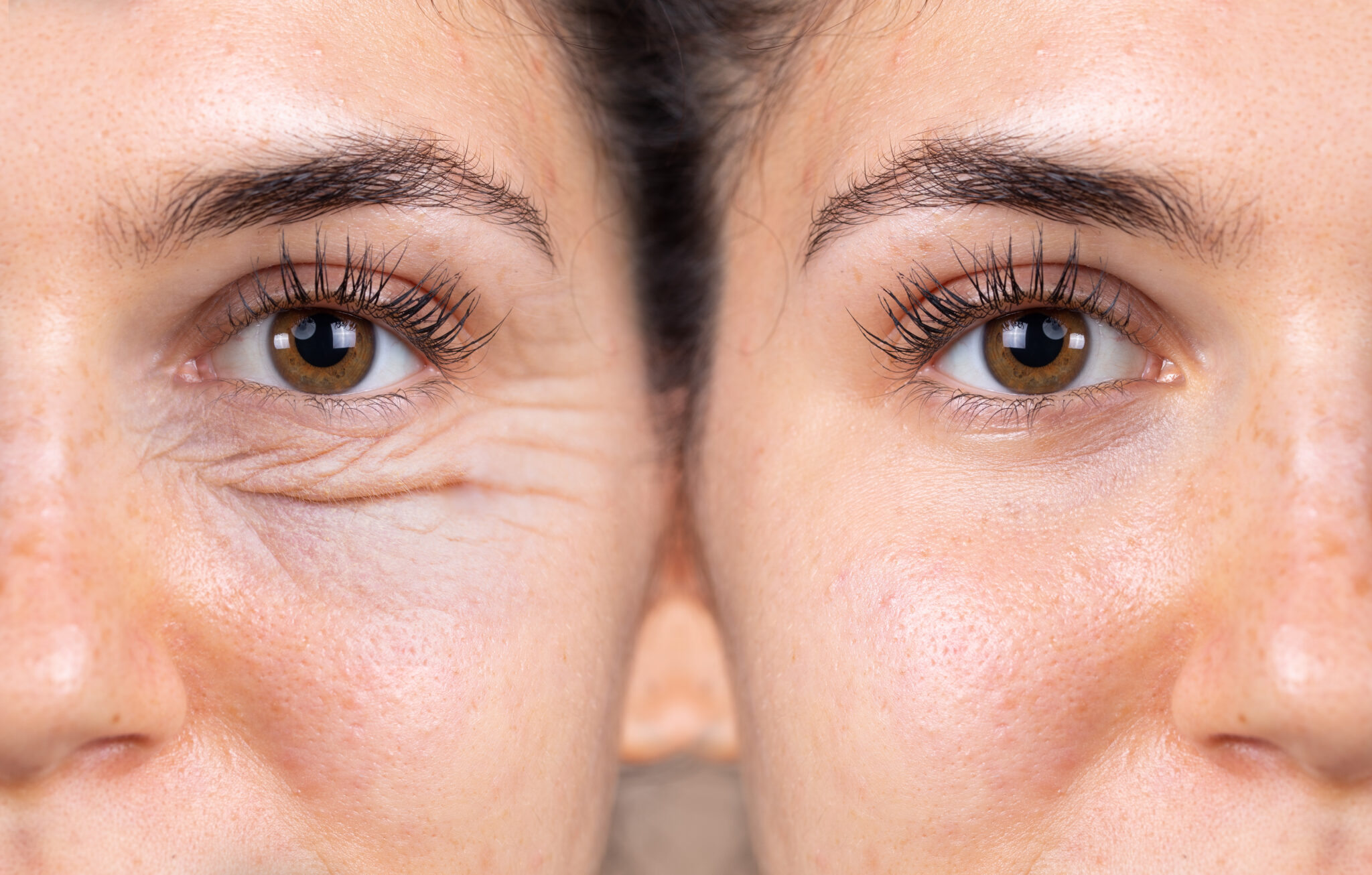
The first signs often appear as morning swelling that fades slowly throughout the day. Puffy eyes become more noticeable after long nights or salty meals. The swelling isn’t always dramatic—it often shows up subtly and worsens gradually over time. What begins as an occasional puffiness can turn into a consistent feature. Many assume it’s due to sleep or fluid retention. But in many cases, there’s more happening underneath. Fat pads around the eyes can shift with age, creating visible bulges. Fluid can accumulate when circulation slows or when lymphatic drainage weakens. Over-the-counter creams rarely solve the underlying issue. They may reduce fluid temporarily, but they don’t address structural causes.
As we age, fat compartments around the eyes can protrude through weakened tissue
As we age, fat compartments around the eyes can protrude through weakened tissue. This fat isn’t new—it has always been there, cushioning the eyeball. But as connective tissue thins, the fat pushes forward. The result is puffiness that doesn’t disappear, even with rest. Gravity, genetics, and repetitive expressions can all influence this process. Some people develop puffiness in their 30s, while others see it much later. Eyelid skin also becomes thinner with age, making the swelling more noticeable. The natural support structure weakens, allowing pockets of fat to appear more prominent. This process doesn’t always coincide with aging elsewhere on the face, which can make it feel more isolated.
Not all puffiness is due to fat—some comes from fluid buildup or allergic inflammation
Not all puffiness is due to fat—some comes from fluid buildup or allergic inflammation. Allergies trigger histamine release, causing blood vessels to dilate and leak fluid. That leads to swelling around delicate eye tissue. Seasonal allergens, cosmetics, or food sensitivities may contribute. Fluid can also pool due to sinus issues or poor circulation. Sleeping flat, alcohol use, or chronic fatigue often make the condition worse. In these cases, the puffiness fluctuates throughout the day. Unlike fat-related swelling, fluid retention usually responds to lifestyle changes or medication. Identifying the cause is critical because treatments vary based on the source of the puffiness.
Surgical correction focuses on removing or repositioning the fat that causes persistent bulges
Surgical correction focuses on removing or repositioning the fat that causes persistent bulges. Blepharoplasty—also known as eyelid surgery—targets the lower eyelids in these cases. The procedure involves a hidden incision inside the eyelid or just beneath the lash line. Surgeons then remove or redistribute fat to smooth the contour. Some prefer repositioning fat instead of removing it, to avoid hollowing. The approach depends on patient anatomy and aesthetic goals. If excess skin is present, it can also be trimmed during surgery. Muscle tightening may be added for better support. The results often last many years, especially if the procedure is done before significant skin laxity develops.
Recovery involves temporary swelling, but most patients return to daily activities within two weeks
Recovery involves temporary swelling, but most patients return to daily activities within two weeks. Initial bruising usually fades by day ten. Cold compresses help reduce swelling during the first 48 hours. Sleeping with the head elevated prevents additional fluid accumulation. Most patients describe the discomfort as mild, more like pressure than pain. Stitches are usually removed after five to seven days, unless dissolvable ones are used. Full healing takes longer, but most improvements are visible within a month. Makeup can be resumed once incisions are closed. Clear aftercare instructions are essential to minimize risk and maximize results.
Choosing a qualified oculoplastic or facial surgeon reduces the risk of overcorrection or asymmetry
Choosing a qualified oculoplastic or facial surgeon reduces the risk of overcorrection or asymmetry. These professionals specialize in the delicate anatomy around the eyes. They understand how much fat to remove—or leave—for natural-looking results. Over-removal can lead to a sunken appearance or loss of eye support. This area is unforgiving to error, and revisions are difficult. That’s why experience and precision are critical. Consultations should include photos, anatomical explanations, and honest discussions about expectations. Surgeons must evaluate bone structure, skin quality, and fat distribution before offering a treatment plan. Proper technique ensures that the eyes appear refreshed, not altered.
For those not ready for surgery, temporary fillers can camouflage hollows and balance contours
For those not ready for surgery, temporary fillers can camouflage hollows and balance contours. Hyaluronic acid-based products are commonly used to fill tear trough depressions. When placed correctly, fillers reduce contrast between puffiness and sunken areas. This creates a smoother transition from eyelid to cheek. However, fillers don’t remove the bulge—they mask it by filling nearby volume loss. Results last several months and require maintenance. Not all patients are candidates for this approach. If puffiness is extreme or the skin is very loose, fillers may worsen the appearance. Experienced injectors assess suitability carefully before proceeding. The outcome depends on skill, product selection, and facial anatomy.
Some patients explore laser treatments or radiofrequency devices to tighten mild skin laxity
Some patients explore laser treatments or radiofrequency devices to tighten mild skin laxity. These noninvasive options target the surface layer of skin or deeper collagen structures. They can improve texture and reduce fine lines, but they don’t remove fat. In cases where puffiness is minimal and skin sagging is the main concern, these devices may help. Results vary depending on skin type, age, and treatment intensity. Sessions may need to be repeated for sustained improvement. These methods work best as early intervention or post-surgical maintenance. They offer gradual change rather than dramatic correction. Consultation determines whether technology or surgery is more effective for specific concerns.
Fat removal alone is not always enough if the cheek structure lacks support beneath the eyelid
Fat removal alone is not always enough if the cheek structure lacks support beneath the eyelid. The lower lid and upper cheek form a continuous contour. If the cheek descends with age, it leaves a hollow beneath the eye. In such cases, eyelid surgery may be combined with mid-face lifting. Restoring cheek volume provides better transition and reduces tension on the lower eyelid. Without this balance, removing eye fat can exaggerate hollowness or create unnatural shape. That’s why surgical plans must include full facial context. Treating the eye area in isolation can lead to inconsistent results. Comprehensive analysis ensures lasting and harmonious improvement.
Long-term results depend on genetics, skin quality, and aging patterns more than the surgical technique itself
Long-term results depend on genetics, skin quality, and aging patterns more than the surgical technique itself. Even with perfect surgery, aging continues. Skin loses elasticity, and fat shifts over time. The procedure can delay but not stop these changes. Healthy habits, sun protection, and regular checkups extend the results. Some patients require minor touch-ups years later. Others maintain their outcome for a decade or more. Consistency in skincare and lifestyle choices supports structural longevity. The earlier puffiness is addressed, the easier it is to maintain natural contours. Surgery resets the baseline, but future aging still plays a role.
